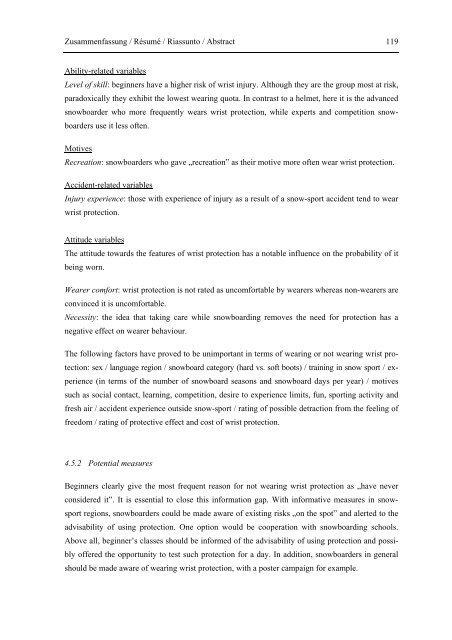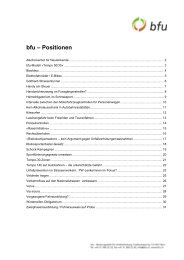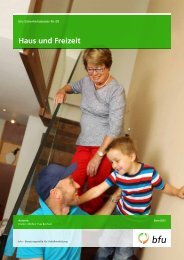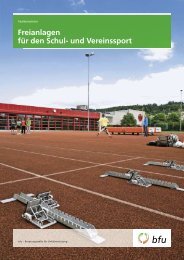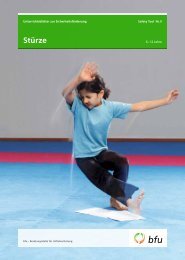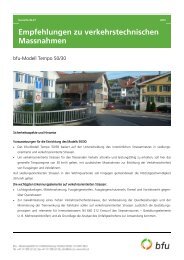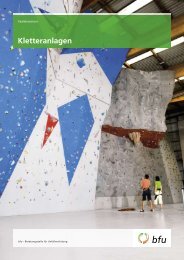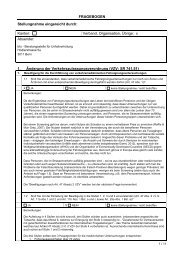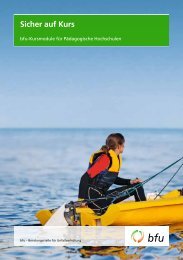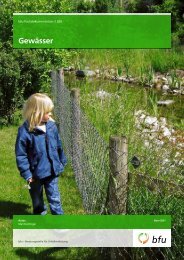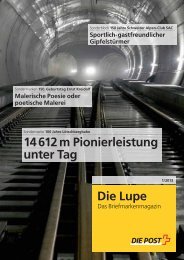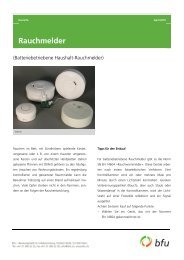Persönliche Schutzausrüstung im Schneesport – Erhebung ... - BfU
Persönliche Schutzausrüstung im Schneesport – Erhebung ... - BfU
Persönliche Schutzausrüstung im Schneesport – Erhebung ... - BfU
Sie wollen auch ein ePaper? Erhöhen Sie die Reichweite Ihrer Titel.
YUMPU macht aus Druck-PDFs automatisch weboptimierte ePaper, die Google liebt.
Zusammenfassung / Résumé / Riassunto / Abstract 119<br />
Ability-related variables<br />
Level of skill: beginners have a higher risk of wrist injury. Although they are the group most at risk,<br />
paradoxically they exhibit the lowest wearing quota. In contrast to a helmet, here it is the advanced<br />
snowboarder who more frequently wears wrist protection, while experts and competition snow-<br />
boarders use it less often.<br />
Motives<br />
Recreation: snowboarders who gave „recreation” as their motive more often wear wrist protection.<br />
Accident-related variables<br />
Injury experience: those with experience of injury as a result of a snow-sport accident tend to wear<br />
wrist protection.<br />
Attitude variables<br />
The attitude towards the features of wrist protection has a notable influence on the probability of it<br />
being worn.<br />
Wearer comfort: wrist protection is not rated as uncomfortable by wearers whereas non-wearers are<br />
convinced it is uncomfortable.<br />
Necessity: the idea that taking care while snowboarding removes the need for protection has a<br />
negative effect on wearer behaviour.<br />
The following factors have proved to be un<strong>im</strong>portant in terms of wearing or not wearing wrist pro-<br />
tection: sex / language region / snowboard category (hard vs. soft boots) / training in snow sport / experience<br />
(in terms of the number of snowboard seasons and snowboard days per year) / motives<br />
such as social contact, learning, competition, desire to experience l<strong>im</strong>its, fun, sporting activity and<br />
fresh air / accident experience outside snow-sport / rating of possible detraction from the feeling of<br />
freedom / rating of protective effect and cost of wrist protection.<br />
4.5.2 Potential measures<br />
Beginners clearly give the most frequent reason for not wearing wrist protection as „have never<br />
considered it”. It is essential to close this information gap. With informative measures in snowsport<br />
regions, snowboarders could be made aware of existing risks „on the spot” and alerted to the<br />
advisability of using protection. One option would be cooperation with snowboarding schools.<br />
Above all, beginner’s classes should be informed of the advisability of using protection and possibly<br />
offered the opportunity to test such protection for a day. In addition, snowboarders in general<br />
should be made aware of wearing wrist protection, with a poster campaign for example.


